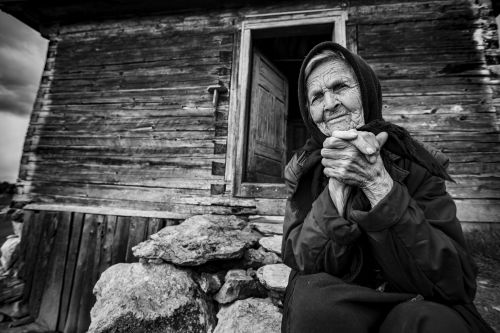Zsuzsanna Tulipán
Raising Awareness about the World
Photographs by Zsófia Mohos, Botond Nagy and Anna Szász-Bányász
The material for the photography exhibition realised as part of the 2nd National Salon of Folk Art presents was selected from three series: one each by three young photographers. The Zsófia Mohos’ series, titled The Palóc People, presents some of her documentarist pictures, which she took for several years in Rimóc, Nógrád County and in Kupuszina, Vojvodina as well as from her photos of the ‘Virgin Mary’s girls’, who serve at religious holidays and pilgrimages. During her long-term project (Crooked Country), which she began working on in 2020, she sought out villages, where young and old people dressed in folk costumes can still be seen. She bases her presentation of the local characteristics of Palóc culture on her personal experiences: instead of a visual reportage, she makes lyrical compositions that are balanced yet evoke an emotional response. In her photos taken during the pilgrimages the colour and light effects of the softly contoured landscape and the snapshots of religious devotion create a context for interpretation that point beyond themselves. While she takes photographs during her work, she will also share the life stories of the elderly inhabitants of the villages as well as their view of the world, their faith and love of life. The complete series of the Palóc land and the stories related by those living can soon be read in depth in a volume that is in the making right now.
Built on the progressive tradition of socio-documentarist photography, Botond Nagy’s portrait series, titled Soul Mirror, captures the everyday labour and the environment of the Sekler minority. Seeking out living crafts, the photographer met the elderly subjects of his portraits, of whom he took authentic and deeply personal pictures. His wide-angle shots allowing an insight into the environments of the portrayed people are distinguished by a lively texture and material quality, while in some cases they convey the power of nature and how time defines the human condition. The portraits reduced to faces capture the essence of the depicted characters, thanks to which the men and women in the photos engage in a peculiar, intensive metacommunication with the viewers.
Anna Szász-Bányász takes photographs of her family’s self-sufficient farm in Gyergyóújfalu, Transylvania. Her series titled The Future Is No Longer the Same was inspired by her desire to overwrite the often false stereotypes that exist about the peasant lifestyle. Her photos of the day-to-day running and key protagonists of the farm, the cows and the stages of cheese-making are not limited to providing a dry inventory: their expressive power is achieved through the picturesque depiction of the environment, emphasis on the abstract facet of the flora and fauna as well as the enigmatic presentation of forms, tones and lights. Her series also ventures into the realm of contemplation, involuntary remembrance, the preservation of things and the desire for a home.
All of the three photographers expound their messages in series that often take them years of work, while always keeping emotions at the forefront.
In the heroic age of documentarist photography, in the 1930s and 1940s, photographers from Dorothea Lange through Walker Evans to Kata Kálmán were driven by the urge to expose particular social problems with the aim of drawing attention to them and provoke people to act. The next generation were already driven by personal experiences and fo cussed on showing various phenomena. At the same time, a photographic approach seeking to preserve a changing or disappearing reality, that of ethnic groups and their traditions, the environment as well as the material and natural world has existed since the emergence of photography. Foremost representatives of this approach in the past included Edward Curtis, Eugène Atget, Berenice Abbott and Rudolf Balogh, and in the present – to name only some Hungarians – László Kunkovács, Ottó Kaiser and Péter Korniss. Our selection presented under the collective title of Raising Awareness about the World confirms that this subject is still topical in the 21st century and that the path of photography is still chosen by young people who, urged by an instinctive sensitivity, bring the values of the traditional peasant lifestyle closer to others, even drawing the attention of their peers. As Sándor Csoóri wrote for Péter Korniss’ first exhibition organised in the Kunsthalle Budapest: “… the art of photography is not only to record the world but also to arouse awareness about the world.”
Zsuzsanna Tulipán
curator of the exhibition


